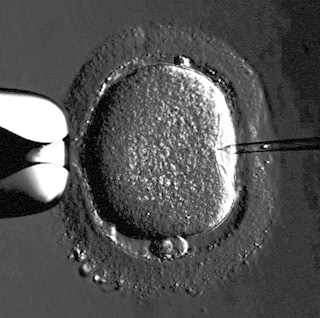
Reproductive medicine: Scientific technical developments, consequences and general conditions of use
- Project team:
Christoph Revermann (Projektleitung), Bärbel Hüsing
- Thematic area:
- Topic initiative:
Committee on Education, Research and Technology Assessment
- Analytical approach:
TA project
- Startdate:
2009
- Enddate:
2010
sprungmarken_marker_2220
Background and central aspects of the topic
Since the birth of the first "test-tube baby" in 1978, there have been significant developments in reproductive medicine (also called assisted reproduction). Today, the term also covers extracorporeal fertilisation with subsequent embryo transfer (in vitro fertilisation, IVF), intracytoplasmic injection of sperm into the ovum (ICSI) with subsequent embryo transfer, cryopreservation of germ cells, impregnated ova and embryos, and the later use of these in assisted reproduction. Whereas the original target of reproductive medicine was female infertility that was organic in origin, further specific techniques have now been and will be developed. These permit:
- An extension of the indications (e.g., treatment of male infertility, too)
- Replacing the individuals involved in the reproductive process (e.g., ova and sperm donations, surrogate mothers)
- The spatial and temporal disconnect between different phases of the reproductive process (e.g., cryopreservation)
- The (morphological and genetic) control and modification of reproductive cells or of the early embryo (e.g., through sperm selection procedures, polar body diagnosis, pre-implantation diagnosis, "quality selection" and reduction in the number of transferred embryos – so-called elective single embryo transfer – possibly long term through genetic treatment and reproductive cloning).
In addition, reproductive medicine is closely tied to the isolation of and research on human embryonic stem cells and to therapeutic and reproductive cloning – areas which build upon techniques from reproductive medicine.
One of the aims of current research is to increase the efficacy of assisted reproduction (e.g., through greater targeted preselection of the transferred embryos) and to reduce the risks for women and children (particularly by reducing the number of multiple pregnancies, which always constitute a health risk and often also entail psychosocial stress).
An international comparison reveals great differences with regard to
- Whether assisted reproduction procedures are permitted or not, and if so with which objectives and under which general conditions
- The degree to which these procedures are actually employed in reproductive medicine
- The intended and unintended consequences associated with the respective procedures.
In international comparison, the conditions in Germany can be considered rather restrictive; particularly relevant here are the regulations set down in the law for the protection of embryos. A recently published expert opinion commissioned by the Friedrich Ebert Foundation made a particular topic of the high rates of multiple pregnancies in Germany in comparison to countries in which single-embryo transfer is permitted yet which at the same time exhibit similar or even higher birth rates per treatment cycle.
Objectives and approach
Especially against this background, TAB was commissioned to provide an overview of the current status and perspectives of assisted reproductive medicine and to study the international experience regarding the consequences of reproductive medicine and the respective national circumstances of its use. Aspects of pre-implantation diagnosis are included to the extent as it or pre-implantation screening is employed to increase the success rates of technically assisted reproduction.
The purpose of this analysis of the international experience with the use of these techniques is to show what interrelationship exists between the individual frameworks for the use of reproductive medicine and its consequences. In addition, non-technical, alternative interventions used to combat unwanted childlessness are included for comparison. These analyses should provide indications of whether and how the legal parameters that exist in Germany as well as the general conditions for its application can be further developed. The study is divided into the following steps:
- Current status and perspectives of interventions in the field of reproductive medicine and non-technical alternatives, including:
- A survey of the international status and developmental trends in the clinical use of reproductive medicine interventions; Germany's position in an international comparison;
- A summary of the current status of knowledge on the efficacy and on the medical and psychological consequences for women and children;
- The current status and future perspectives of new scientific and technical developments in reproductive medicine;
- The contribution of these developments to increasing the efficacy of treatments, to reducing the health risks for women and children, and to limiting the unintentional consequences;
- A comparison of the efficacy of interventions in the field of reproductive medicine with that of alternative, non-technical interventions (particularly with psychosocial and psychotherapeutic counselling concepts).
- The legal framework for interventions in reproductive medicine, including:
- An international comparative overview of the legal regulation of application of assisted reproduction;
- An investigation into the extent to which new developments in reproductive medicine are covered by the current laws in Germany, or are either not or not sufficiently regulated here; this includes an analysis of data protection issues;
- An analysis of the specific details of the legal framework in those countries at the forefront of reproductive medicine or in the countries with comprehensive regulation of reproductive medicine;
- An inference of starting points for a possible further development of the legal framework in Germany;
- The non-legal conditions for interventions in reproductive medicine and for alternative techniques, including:
- The identification of the non-legal conditions which positively influence either the efficacy of procedures in reproductive medicine on an international scale or the avoidance of unintentional consequences (e.g., linking counselling offers with reproductive medical treatment; regulating access to relevant interventions);
- An inference of starting points for a possible further development of these general conditions in Germany.
Publications
Revermann, C.; Hüsing, B.
2011. edition sigma
Revermann, C.; Hüsing, B.
2010. Büro für Technikfolgen-Abschätzung beim Deutschen Bundestag (TAB). doi:10.5445/IR/1000137872
Revermann, C.; Hüsing, B.
2010. Büro für Technikfolgen-Abschätzung beim Deutschen Bundestag (TAB). doi:10.5445/IR/1000103517
In the Bundestag
- Vorgang - Bericht, Gutachten, Programm im Dokumentations- und Informationssystem für Parlamentsmaterialien (DIP)
